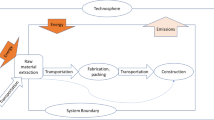Abstract
Purpose
Service life of buildings is an essential parameter to evaluate its operational impact in life cycle assessment (LCA). Although most studies assume building service life about 75 to 100 years since no reliable data are available, its accurate quantification is still an unresolved work. To avoid wrong generalizations, the determination of the service life of buildings according to the characteristics of every region is required.
Methods
Life table, a methodology traditionally used in demographic studies, has been used in this paper to estimate the service life of buildings. This methodology has been applied to the dwelling stock of Spain for each of its 19 regions. Data acquisition and sources have been pointed out. The building obsolescence has been considered in the moment that they are in a ruinous state.
Results and discussion
Life table of buildings showed that the average service life of a residential building constructed in 2001 in Spain was expected to be 80 years. Significant different results of service life among regions were found, from 54 years for a building in Ceuta to 95 years in La Rioja. It also showed that 50 % of total Spanish dwellings are younger than 30 years, and they are expected to reach the ruinous state in 2063 to 2081.
Conclusions
Life table applied to buildings allows determining their service life. Its quantification is based on the buildings census, given by official institutions. Building census has to consider the year of construction and the state of conservation of the building to be applied in buildings' life table. Building service life can be used in LCA, renovation and deconstruction of the building stock, and future construction and demolition debris management.


Similar content being viewed by others
References
Aktas CB, Bilec MM (2012a) Impact of lifetime on US residential building LCA results. Int J Life Cycle Assess 17:337–349
Aktas CB, Bilec MM (2012b) Service life prediction of residential interior finishes for life cycle assessment. Int J Life Cycle Assess 17:362–371
Anderson T, Brandt E (1999) The use of performance and durability data in assessment of life time serviceability. In: Lacasse MA, Vanier DJ (eds) 8th International Conference on Durability of Building Materials and Components (DBMC). NRC Research Press, Ottawa, pp. 1813–1820
Baum A (1991) Property investment, depreciation and obsolescence. Routledge, London
Benveniste G, Gazulla C, Fullana P, Celades I, Ros T, Zaera V, Godes B (2011) Life cycle assessment and product category rules for the construction sector. The floor and wall tiles sector case study. Inf Constr 63:71–81
Blengini GA, Di Carlo T (2010) Energy-saving policies and low-energy residential buildings: an LCA case study to support decision makers in Piedmont (Italy). Int J Life Cycle Assess 15:652–665
Bradley PE, Kohler N (2007) Methodology for the survival analysis of urban building stocks. Build Res Inf 35:529–542
CEN (2012) CEN/TC 350—sustainability of construction works. http://portailgroupe.afnor.fr/public_espacenormalisation/CENTC350/building_level.html. Accessed 12 Dec 2012
de Gracia A, Rincón L, Castell A, Jiménez M, Boer D, Medrano M, Cabeza LF (2010) Life cycle assessment of the inclusion of phase change materials (PCM) in experimental buildings. Energ Build 42:1517–1523
EN (2011) EN 15978:2011—sustainability of construction works—assessment of environmental performance of buildings—calculation method. CEN, Brussels
Gleeson ME (1981) Estimating housing mortality. J Am Plann Assoc 48:185–194
Hovde PJ, Moser K (2004) Performance based methods for service life prediction—state of the art reports part A & part B. CIB W080/RILEM 175-SLM service life methodologies prediction of service life for buildings and components. International Council for Research and Innovation in Building and Construction (CIB), Rotterdam
INE, Instituto Nacional de Estadística (2007) 2001 Population and Housing Census. National Institute of Statistics, Madrid. http://www.ine.es/inebmenu/mnu_cifraspob.htm. Accessed 15 Apr 2011
ISO 15686-1:2011 (2011) Buildings and constructed assets—service life planning—part 1: general principles and framework. International Organization for Standardization, Geneva
Johnstone I (2001) Energy and mass flows of housing: estimating mortality. Build Environ 36:43–51
Kellenberger D, Althaus H-J (2009) Relevance of simplifications in LCA of building components. Build Environ 44:818–825
Kliukas R, Kudzys A (2004) Probabilistic durability prediction of existing building elements. J Civ Eng Manag 10:107–112
Marteinsson B (2005) Service life estimation in the design of buildings—a development of the factor method. KTH Research School, Gavle
McDonough W, Braungart M (2008) Cradle to cradle: remaking the way we make things. Jonathan Cape, London
Muñoz I, Gazulla C, Bala A, Puig R, Fullana P (2008) LCA and ecodesign in the toy industry: case study of a teddy bear incorporating electric and electronic components. Int J Life Cycle Assess 14:64–72
Rincón L (2011) Material flow analysis of the building sector in Lleida. Ph.D. thesis, Universitat de Lleida, Spain
Thomsen A, van der Flier K (2011) Understanding obsolescence: a conceptual model for buildings. Build Res Inf 39:352–362
Zavadskas EK, Kaklauskas A, Gulbinas A (2004) Multiple criteria decision support web based system for building refurbishment. J Civ Eng Manag 10:77–85
Acknowledgments
The work was partially funded by the Spanish government (project ENE2008-06687-C02-01/CON and project ENE2011-28269-C03-02) and the European Union (COST Action COST TU0802). The authors would like to thank the Catalan Government for the quality accreditation given to their research group (2009 SGR 534). Lídia Rincón would like to thank the University of Lleida for her research fellowship.
Author information
Authors and Affiliations
Corresponding author
Additional information
Responsible editor: Pere Fullana-i-Palmer
Rights and permissions
About this article
Cite this article
Rincón, L., Pérez, G. & Cabeza, L.F. Service life of the dwelling stock in Spain. Int J Life Cycle Assess 18, 919–925 (2013). https://doi.org/10.1007/s11367-013-0552-x
Received:
Accepted:
Published:
Issue Date:
DOI: https://doi.org/10.1007/s11367-013-0552-x




